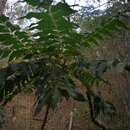pms
nòm ant ël fil


Jagera pseudorhus, commonly named foambark, is a species of rainforest trees, in the northern half of eastern Australia and in New Guinea, constituting part of the flowering plant family Sapindaceae. Named for the saponin foam that forms on the bark after heavy rain.
In Australia, they grow naturally from the Manning River (35° S), New South Wales to the Bloomfield River (15° S) in far north Queensland.[2][3][4][5] In New Guinea they grow naturally widespread.[6] The habitat is tropical and sub-tropical rainforests, monsoon forest and gallery forest on soils of good fertility. Other common names include ferntop and pink tamarind.
Two varieties have formal botanical descriptions:
Growing to 30 m (98 ft) tall and 50 cm (20 in) in trunk diameter. Though smaller in cultivation. The bark is smooth and grey with horizontal raised ridges. The base of larger trees are often flanged.
Leaves are alternate and pinnate with eight to twenty six leaflets. The leaflets 4 to 6 cm long. Toothed, not equal at the base, with a pointed tip. Branchlets and the underside of leaves hairy.
Yellow brown flowers form on panicles in the months of March to May. The fruit forms in August to November. Being a hairy capsule with three cells around 18 mm (0.7 in) long. Capsules mature to a brown colour, after being a violet pink. One seed in each cell, being covered in aril. Care needs to be taken when handling the capsule, as the hairs may cause skin irritation.
Fruit eaten by the Australian king parrot and the green catbird. Germination from fresh seed is not particularly difficult.
The form of this tree makes it well suited as an ornamental. Indigenous Australians use foam from crushed bark or leaves as a fish poison to kill fish enabling easy catching. The foam was also used as a soap.
Jagera pseudorhus, commonly named foambark, is a species of rainforest trees, in the northern half of eastern Australia and in New Guinea, constituting part of the flowering plant family Sapindaceae. Named for the saponin foam that forms on the bark after heavy rain.
In Australia, they grow naturally from the Manning River (35° S), New South Wales to the Bloomfield River (15° S) in far north Queensland. In New Guinea they grow naturally widespread. The habitat is tropical and sub-tropical rainforests, monsoon forest and gallery forest on soils of good fertility. Other common names include ferntop and pink tamarind.
Two varieties have formal botanical descriptions:
Jagera pseudorhus var. integerrima S.T.Reynolds – endemic to the Atherton Tableland, Qld, Australia Jagera pseudorhus var. pseudorhus – NSW, Qld, Australia and New GuineaJagera pseudorhus, conocido en inglés como foambark (corteza espumosa), es un árbol del bosque lluvioso del este de Australia. Se le llama así por la espuma de saponina que se forma en la corteza después de una fuerte lluvia.
Crece desde el río Manning (35° S), Nueva Gales del Sur hasta el río Bloomfield (15° S) en el extremo norte de Queensland. El hábitat son los bosques lluviosos tropicales y subtropicales en suelos de buena fertilidad.
Crece a una altura de 30 metros, y alcanza 50 cm de diámetro en el tronco. Sin embargo es más pequeño en cultivo. La corteza es lisa y gris con estrías elevadas horizontales. La base de los árboles maduros están con frecuencia rebordeadas.
Las hojas son alternadas y pinadas, con ocho a veintiséis foliolos. Los foliolos miden de 4 a 6 cm de largo. Dentados, desiguales, con un extremo puntiagudo. Las ramillas y el envés de las hojas son vellosos.
Flores amarillas parduscas se forman en panículas en los meses de marzo a mayo. El fruto se forma de agosto a noviembre. Siendo una cápsula con tres celdas de alrededor de 18 mm de largo. Las cápsulas maduran a un color café, después de ser de un color rosa violáceo. Existe una semilla en cada celda, estando cubierta en un arilo. Se necesita tener cuidado al manejar la cápsula, ya que los vellos pueden causar irritación en la piel.
El fruto es comido por las aves loro rey australiano y Ailuroedus crassirostris. La germinación de la semilla fresca no es particularmente difícil.
La hermosa forma de este árbol facilita su uso como ornamental. Los aborígenes australianos usaron la espuma de la corteza como jabón y veneno para peces.
Jagera pseudorhus, conocido en inglés como foambark (corteza espumosa), es un árbol del bosque lluvioso del este de Australia. Se le llama así por la espuma de saponina que se forma en la corteza después de una fuerte lluvia.
Crece desde el río Manning (35° S), Nueva Gales del Sur hasta el río Bloomfield (15° S) en el extremo norte de Queensland. El hábitat son los bosques lluviosos tropicales y subtropicales en suelos de buena fertilidad.